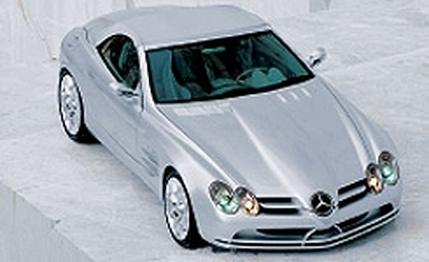 First Drive Review
First Drive Review
When the production version of the Mercedes SLR finally breaks cover in Frankfurt this September, the war between Mercedes and Ferrari will have shifted from the world's Formula 1 circuits to the street.
The 205-mph rival for Ferrari's 575M Maranello closely resembles the Vision SLR concept unveiled by Mercedes at the 1999 Detroit show, but it has undergone subtle aerodynamic modifications to improve 150-plus-mph stability. Mercedes has gone back to the '50s 300SLR sports racer and reinvented the air brake. A higher rear end now includes a spoiler that rises according to speed and, in an emergency stop, extends to full height to help braking.
Styled by Germans Steffen Köhl and Gorden Wagener, the SLR was engineered under Gordon Murray, the South African engineer responsible for co-developer McLaren's landmark F1 supercar. But whereas the BMW V-12-powered McLaren was mid-engined, the SLR has its supercharged V-8 mounted in front.
Mercedes-Benz boss Jürgen Hubbert says, "With the SLR, Mercedes has taken a new approach to styling-away from the well-worn mid-engine approach." Early on, Hubbert and Murray, technical director for McLaren Cars, argued over the car's basic layout. Murray favored a contemporary mid-engine F1 design. Hubbert, despite wanting to draw a technical link with Formula 1, argued that because the SLR would wear a three-pointed star it should be front-engined like every other Mercedes built for the street.
To solve the traction problem inherent in a powerful front-engined sports car, Murray has positioned the engine behind the front wheels in a front mid-engine location. We believe McLaren has achieved a 50/50 weight distribution.
It's left to the SLR's styling to forge a link with McLaren's Formula 1 cars. The front has a long, downward-sloping hood, the nose thrusting out from the center like the Silberpfeil (Silver Arrow) racers. Horizontal plates on either side of the tapered nose also echo the F1 look. Mercedes will point to the management of airflow below the car as another area that draws from racing. Intake channels direct the flow of air from the nose to the rear F1-style defuser. The long doors mirror those of the 1954 300SL-the SLR's spiritual predecessor-by opening in gullwing fashion, although they are hinged at the A-pillar and not in the roof. Although Mercedes showed the concept as both a coupe and a roadster, it's understood there are no plans for an open-air SLR.
The heart of the SLR is the mighty all-alloy AMG-assembled V-8 engine. A development of the supercharged 5.4-liter, 24-valve V-8 used in the SL55, it pumps out 600 horsepower and about 590 pound-feet of torque. If the SLR meets its target weight, those numbers should translate into a 0-to-60-mph time of perhaps 3.8 seconds and a quarter-mile of less than 12 seconds.
Initially, Murray is believed to have set a target of 1400 kilograms, or 3086 pounds, for the SLR. But despite the carbon-fiber body and chassis, aluminum suspension, and electrohydraulic ceramic disc brakes, it's understood that to meet Mercedes' crash standards and high equipment levels, the production car will come in at about 3550 pounds.
Final assembly of the SLR takes place at the new McLaren Technology Centre in Woking, England. The production pace should run 400 to 500 cars a year. Mercedes plans to build SLRs to order, with deliveries to the U.S. beginning early next year. Expect a price of about $300,000.